Abstract
Public debate about health care reform often focuses on the need for health insurance coverage, but in Latino communities many other barriers also inhibit access to medical care. In addition, basic public health services often go underfunded or ignored. Thus, health care reform efforts, nationally and in each State, must embrace a broader view of the issues if the needs of Latino communities are to be served. This report reviews and summarizes information about the mounting problems Latino communities face in gaining access to medical care. Access to appropriate medical care is reduced by numerous financial, structural, and institutional barriers. Financial barriers include the lack of health insurance coverage and low family incomes common in Latino communities. More than 7 million Latinos (39 percent) go without health insurance coverage. Latinos without health insurance receive about half as much medical care as those who are insured. Structurally, the delivery system organization rarely reflects the cultural or social concerns of the communities where they are located. Therefore, providers and patients fail to communicate their concerns adequately. These communication problems are exacerbated by the extreme shortage of Latino health care professionals and other resources available. Institutional barriers often reflect the failure to consider what it means to provide good service as well as high-quality medical care. Reducing these barriers to medical care requires modifying governmental and institutional policies, expanding the supply of competent providers, restructuring delivery system incentives to ensure primary care and public health services, and enhancing service and satisfaction with care.
Full text
PDF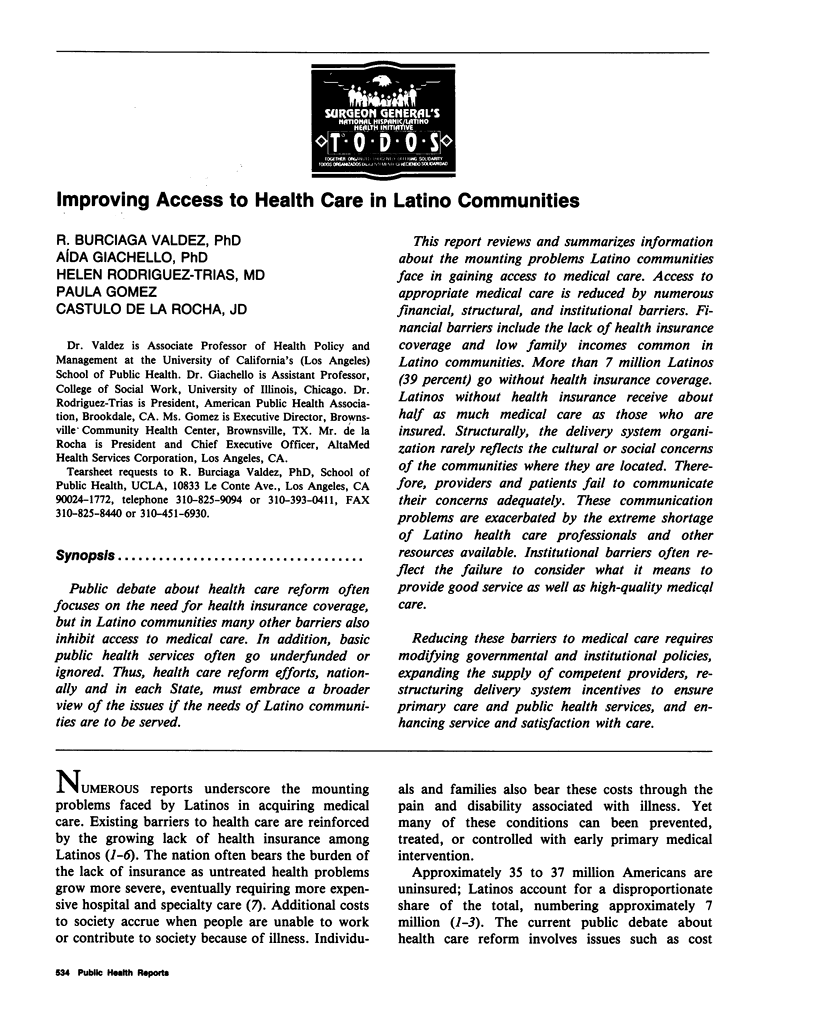
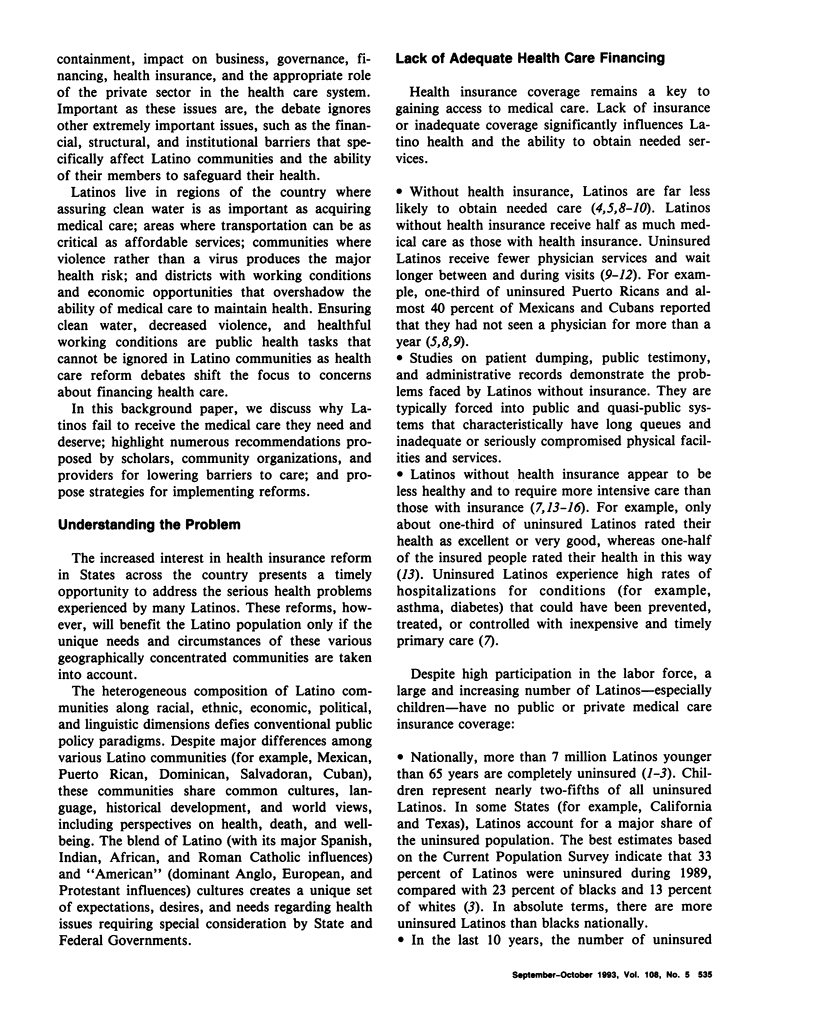
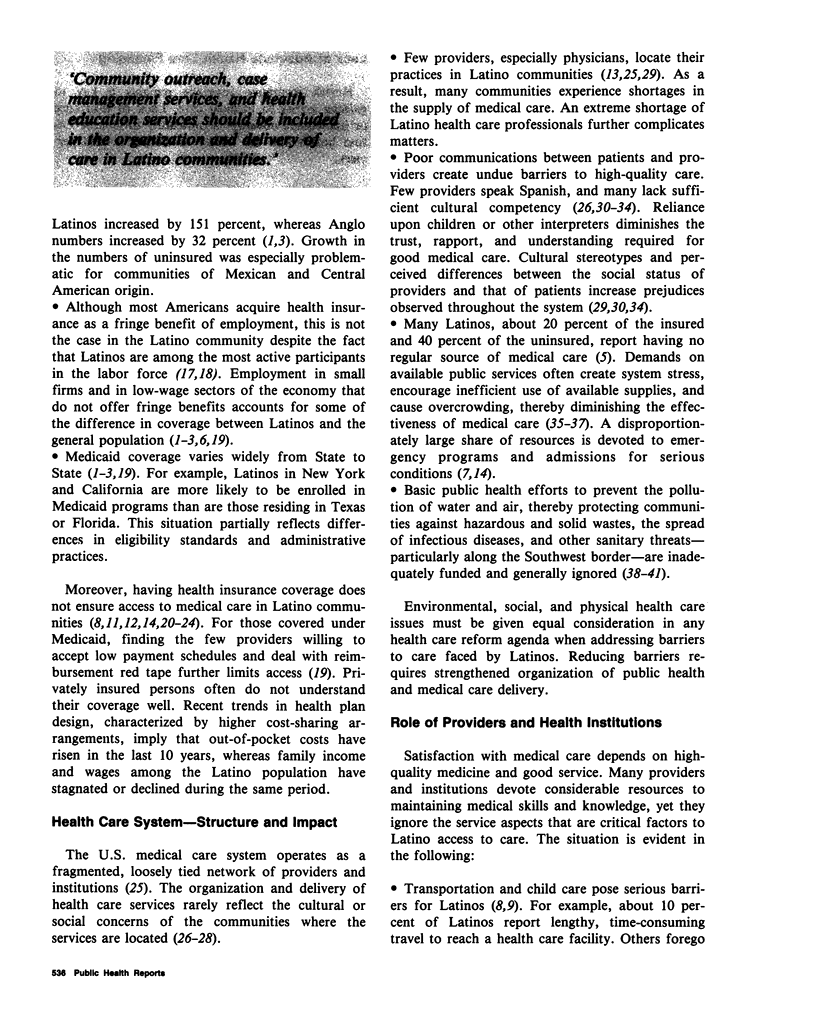
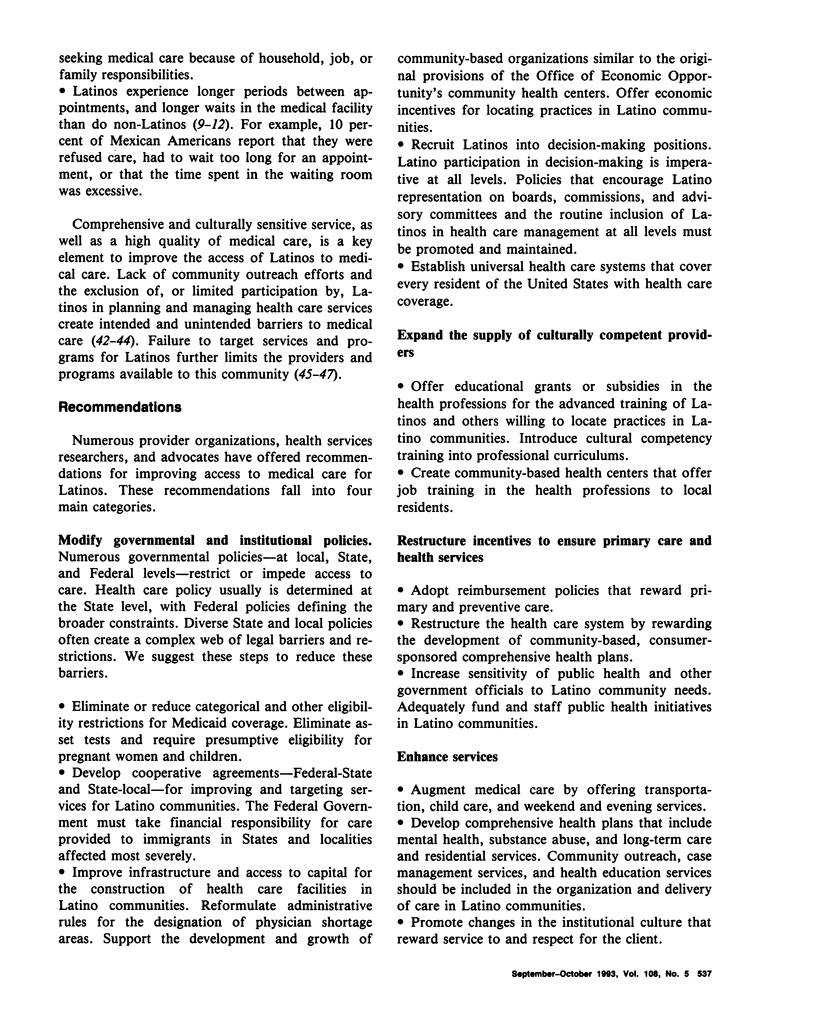
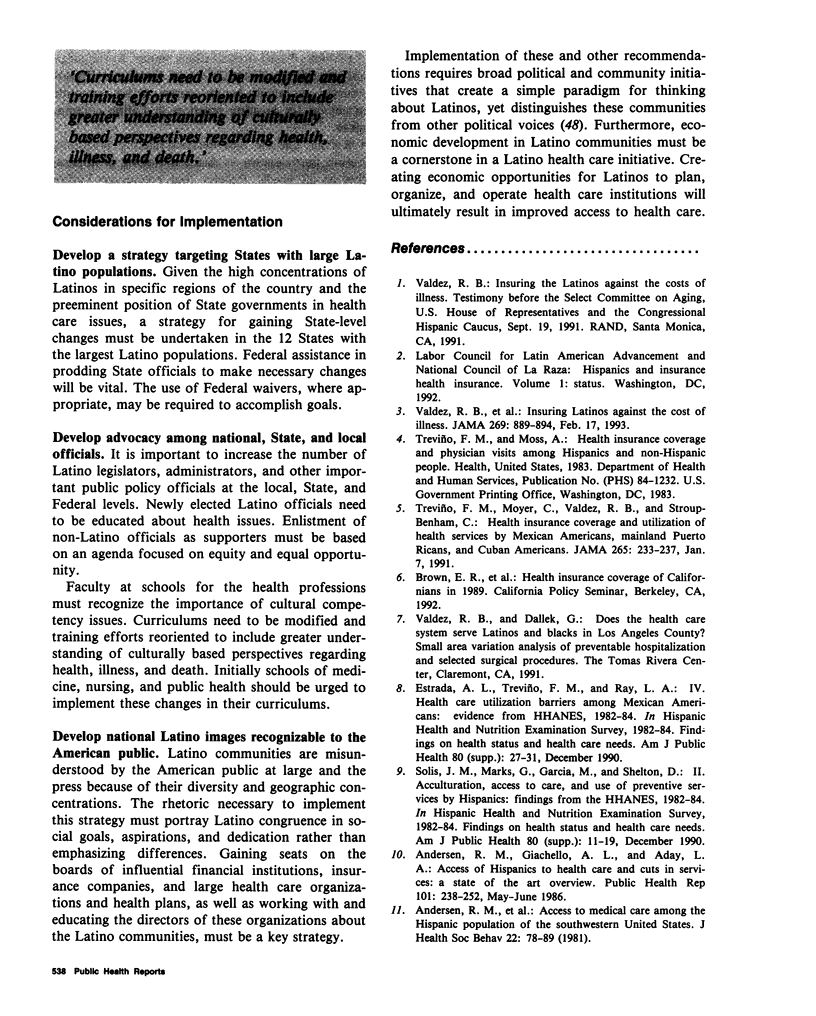
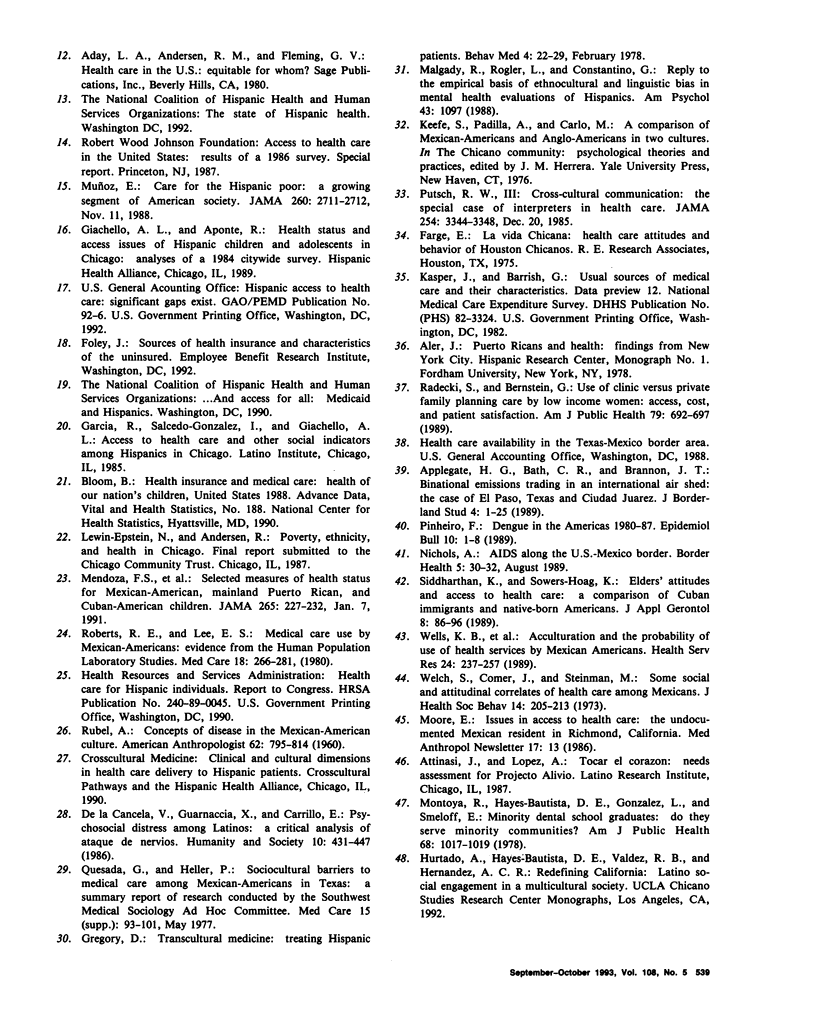
Selected References
These references are in PubMed. This may not be the complete list of references from this article.
- Andersen R. M., Giachello A. L., Aday L. A. Access of Hispanics to health care and cuts in services: a state-of-the-art overview. Public Health Rep. 1986 May-Jun;101(3):238–252. [PMC free article] [PubMed] [Google Scholar]
- Andersen R., Lewis S. Z., Giachello A. L., Aday L. A., Chiu G. Access to medical care among the Hispanic population of the southwestern United States. J Health Soc Behav. 1981 Mar;22(1):78–89. [PubMed] [Google Scholar]
- Mendoza F. S., Ventura S. J., Valdez R. B., Castillo R. O., Saldivar L. E., Baisden K., Martorell R. Selected measures of health status for Mexican-American, mainland Puerto Rican, and Cuban-American children. JAMA. 1991 Jan 9;265(2):227–232. [PubMed] [Google Scholar]
- Montoya R., Hayes-Bautista D., Gonzales L., Smeloff E. Minority dental school graduates: do they serve minority communities? Am J Public Health. 1978 Oct;68(10):1017–1019. doi: 10.2105/ajph.68.10.1017. [DOI] [PMC free article] [PubMed] [Google Scholar]
- Pinheiro F. P. Dengue in the Americas. 1980-1987. Epidemiol Bull. 1989;10(1):1–8. [PubMed] [Google Scholar]
- Putsch R. W., 3rd Cross-cultural communication. The special case of interpreters in health care. JAMA. 1985 Dec 20;254(23):3344–3348. doi: 10.1001/jama.254.23.3344. [DOI] [PubMed] [Google Scholar]
- Quesada G. M., Heller P. L. Sociocultural barriers to medical care among Mexican Americans in Texas: a summary report of research conducted by the Southwest Medical Sociology Ad Hoc Committee. Med Care. 1977 May;15(5 Suppl):93–101. doi: 10.1097/00005650-197705001-00010. [DOI] [PubMed] [Google Scholar]
- Radecki S. E., Bernstein G. S. Use of clinic versus private family planning care by low-income women: access, cost, and patient satisfaction. Am J Public Health. 1989 Jun;79(6):692–697. doi: 10.2105/ajph.79.6.692. [DOI] [PMC free article] [PubMed] [Google Scholar]
- Roberts R. E., Lee E. S. Medical care use by Mexican-Americans: evidence from the human population laboratory studies. Med Care. 1980 Mar;18(3):267–281. [PubMed] [Google Scholar]
- Siddharthan K., Sowers-Hoag K. Elders' attitudes and access to health care: a comparison of Cuban immigrants and native-born Americans. J Appl Gerontol. 1989 Mar;8(1):86–96. doi: 10.1177/073346488900800107. [DOI] [PubMed] [Google Scholar]
- Solis J. M., Marks G., Garcia M., Shelton D. Acculturation, access to care, and use of preventive services by Hispanics: findings from HHANES 1982-84. Am J Public Health. 1990 Dec;80 (Suppl):11–19. doi: 10.2105/ajph.80.suppl.11. [DOI] [PMC free article] [PubMed] [Google Scholar]
- Treviño F. M., Moyer M. E., Valdez R. B., Stroup-Benham C. A. Health insurance coverage and utilization of health services by Mexican Americans, mainland Puerto Ricans, and Cuban Americans. JAMA. 1991 Jan 9;265(2):233–237. doi: 10.1001/jama.1991.03460020087034. [DOI] [PubMed] [Google Scholar]
- Valdez R. B., Morgenstern H., Brown R., Wyn R., Wang C., Cumberland W. Insuring Latinos against the costs of illness. JAMA. 1993 Feb 17;269(7):889–894. [PubMed] [Google Scholar]
- Welch S., Comer J., Steinman M. Some social and attitudinal correlates of health care among Mexican Americans. J Health Soc Behav. 1973 Sep;14(3):205–213. [PubMed] [Google Scholar]
- Wells K. B., Golding J. M., Hough R. L., Burnam M. A., Karno M. Acculturation and the probability of use of health services by Mexican Americans. Health Serv Res. 1989 Jun;24(2):237–257. [PMC free article] [PubMed] [Google Scholar]


